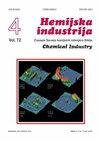动态分光光度法测定水和婴儿食品中杀虫剂双氟脲的研究
IF 0.8
4区 工程技术
Q4 ENGINEERING, CHEMICAL
引用次数: 2
摘要
建立了一种动态分光光度法测定杀虫剂二氟苯脲残留量的方法,并进行了验证。动力学方法基于DFB对磷酸缓冲液中Co 2+存在下过氧化氢氧化磺胺酸(SA)的抑制作用,并在370 nm处进行监测。DFB在0.102 ~ 3.40 μg mL -1和3.40 ~ 23.80 μg mL -1浓度范围内均可测定。根据3σ标准计算该方法的检出限和定量限分别为0.077 μg mL -1和0.254 μg mL -1。0.102、1.70、3.40 μg mL -1 DFB 5次重复测定在第一个浓度区间的相对标准偏差分别为2.08、1.22、1.21%,回收率为94.12 ~ 97.35%。以高效液相色谱法作为平行方法,对动力学方法的结果进行验证。采用固相萃取法测定了加标水和婴儿食品样品中的双氟苯脲浓度。在95%置信水平下,F和t值低于理论值,证实了所建立方法和HPLC方法的一致性。本文章由计算机程序翻译,如有差异,请以英文原文为准。
Development of a kinetic spectrophotometric method for insecticide diflubenzuron determination in water and baby food samples
A kinetic spectrophotometric method for determining residues of insecticide diflubenzuron 1(4-chlorphenyl)-3-(2,6-diflubenzoyl)urea (DFB) has been developed and validated. Kinetic method was based on the inhibitory effect of DFB on the oxidation reaction of sulfanilic acid (SA) by hydrogen peroxide in the presence of Co 2+ ions in a phosphate buffer, which was monitored at 370 nm. DFB can be measured in the concentration interval 0.102 – 3.40 μg mL -1 and 3.40 – 23.80 μg mL -1 . The detection and quantification limits of the method were calculated according to the 3σ criteria and found to be 0.077 μg mL -1 and 0.254 μg Ml ‑1 , respectively. The relative standard deviations for five replicate determinations of 0.102, 1.70 and 3.40 μg mL -1 DFB were 2.08, 1.22 and 1.21 %, respectively, for the first concentration interval, and the recovery percentage values were from 94.12 to 97.35 %. HPLC method was used as a parallel method to verify results of the kinetic method. The kinetic method was successfully applied to determine diflubenzuron concentrations in spiked water and baby food samples after solid phase extraction of the samples. The F and t values at 95% confidence level are lower than the theoretical ones, confirming agreement of the developed and the HPLC method.
求助全文
通过发布文献求助,成功后即可免费获取论文全文。
去求助
来源期刊

Hemijska Industrija
工程技术-工程:化工
CiteScore
1.60
自引率
11.10%
发文量
12
审稿时长
6-12 weeks
期刊介绍:
The Journal Hemijska industrija (abbreviation Hem. Ind.) is publishing papers in the field of Chemical Engineering (Transport phenomena; Process Modeling, Simulation and Optimization; Thermodynamics; Separation Processes; Reactor Engineering; Electrochemical Engineering; Petrochemical Engineering), Biochemical Engineering (Bioreactors; Protein Engineering; Kinetics of Bioprocesses), Engineering of Materials (Polymers; Metal materials; Non-metal materials; Biomaterials), Environmental Engineeringand Applied Chemistry. The journal is published bimonthly by the Association of Chemical Engineers of Serbia (a member of EFCE - European Federation of Chemical Engineering). In addition to professional articles of importance to industry, scientific research papers are published, not only from our country but from all over the world. It also contains topics such as business news, science and technology news, information on new apparatus and equipment, and articles on environmental protection.
 求助内容:
求助内容: 应助结果提醒方式:
应助结果提醒方式:


